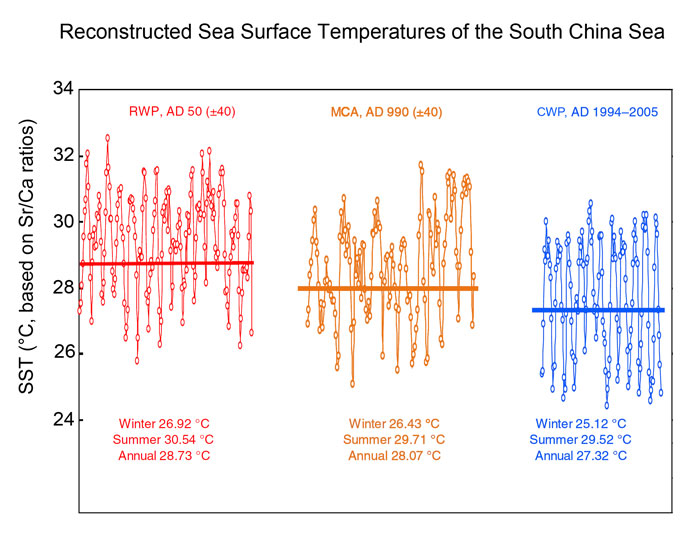| 2 Science">Tweet | Follow @co2science |
Paper Reviewed
Yan, H., Sun, L., Shao, D., Wang, Y. and Wei, G. 2014. Higher sea surface temperature in the northern South China Sea during the natural warm periods of late Holocene than recent decades. Chinese Science Bulletin 59: 4115-4122.
In an eye-opening study published in the Chinese Science Bulletin, Yan et al. (2014) recount how they derived high-resolution sea surface temperature (SST) histories of two 80-year time windows centered at approximately AD 990 and AD 50 within the Medieval Climate Anomaly (MCA) and the Roman Warm Period (RWP), respectively, by analyzing the Sr/Ca ratios and δ18O values of Tradacna gigas (giant clam) shells collected from the northern South China Sea.
As indicated in the figure below, this undertaking revealed that the mean annual SSTs of the 80-year periods centered on AD 990 (MCA) and AD 50 (RWP) were 0.8°C and 1.4°C higher than the mean SST during the AD 1994-2005 portion of the Current Warm Period (CWP). Likewise, they also report that the mean summer SSTs of the MCA and RWP were, respectively, 0.2 and 1.0°C higher than that of the CWP, while the mean winter SSTs of the MCA and RWP were, respectively, 1.3 and 1.8°C higher than that of the CWP.

Reconstructed SSTs based on the Sr/Ca ratios of T. gigas specimens during AD 50 (±40), AD 990 (±40) and AD 1994-2005. Adapted from Yan et al. (2014).
In commenting on their findings, the five Chinese researchers say "our well-calibrated high-resolution tropical SST records, which suggested a warmer MCA than recent decades, did not agree with the results of the IPCC fourth report, which suggested that the recent decades were the warmest in at least the past 1,300 years." And they additionally go on to say that their new temperature reconstruction is "not the only evidence in eastern Asia for a warmer MCA than recent decades."
Yan et al. note, for example, that a winter temperature reconstruction for eastern China based on crop distribution data recorded in Chinese historical documents has also "showed a distinct warm period (AD 930-1310) in the MCA," when "temperatures in the warmest 30-year period were 0.9°C higher than those of 1951-1980," citing Ge et al. (2003). In addition, they note that "tree ring research from the mid-eastern Tibetan Plateau suggested that the temperatures during AD 864-882 and AD 965-994 were comparable or warmer than those during AD 1970-2000," citing Liu et al. (2009).
Last of all, the Chinese group of five write that a "recent study in Qaidam Basin of northwest China also indicated a warmer MCA," noting that "quantitative reconstructions from Sugan Lake and Gahai Lake both suggested a much higher temperature in the MCA than in the recent warm period," citing He et al. (2013). And, we might add, the second NIPCC report of 2013 also provides a wealth of data that contradict the claim of the IPCC that "recent decades were the warmest in at least the past 1,300 years," clearly demonstrating that there has been nothing unusual or unprecedented about the mean level of global warmth experienced over the past 18 years of no significant upward or downward trend.
References
Ge, Q., Zheng, J., Fang, X., Man, Z., Zhang, X., Zhang, P. and Wang, W.-C. 2003. Winter half-year temperature reconstruction for the middle and lower reaches of the Yellow River and Yangtze River, China, during the past 2000 years. The Holocene 13: 933-940.
He, Y., Liu, W., Zhao, C., Wang. C., Wang, H.-Y., Liu, Y., Qin, X.-Y., Hu, Q.-H., An, Z.-S. and Liu, Z.-H. 2013. Solar influenced late Holocene temperature changes on the northern Tibetan Plateau. Chinese Science Bulletin 57: 1053-1059.
Liu, Y., An, X., Linderholm, H.W., Chen, D.-L., Song, H.-M., Cai, Q.-F., Sun, J.-Y. and Tian, H. 2009. Annual temperatures during the last 2485 years in the mid-eastern Tibetan Plateau inferred from tree rings. Science in China Series D: Earth Science 52: 3498-359.
Posted 12 January 2015



